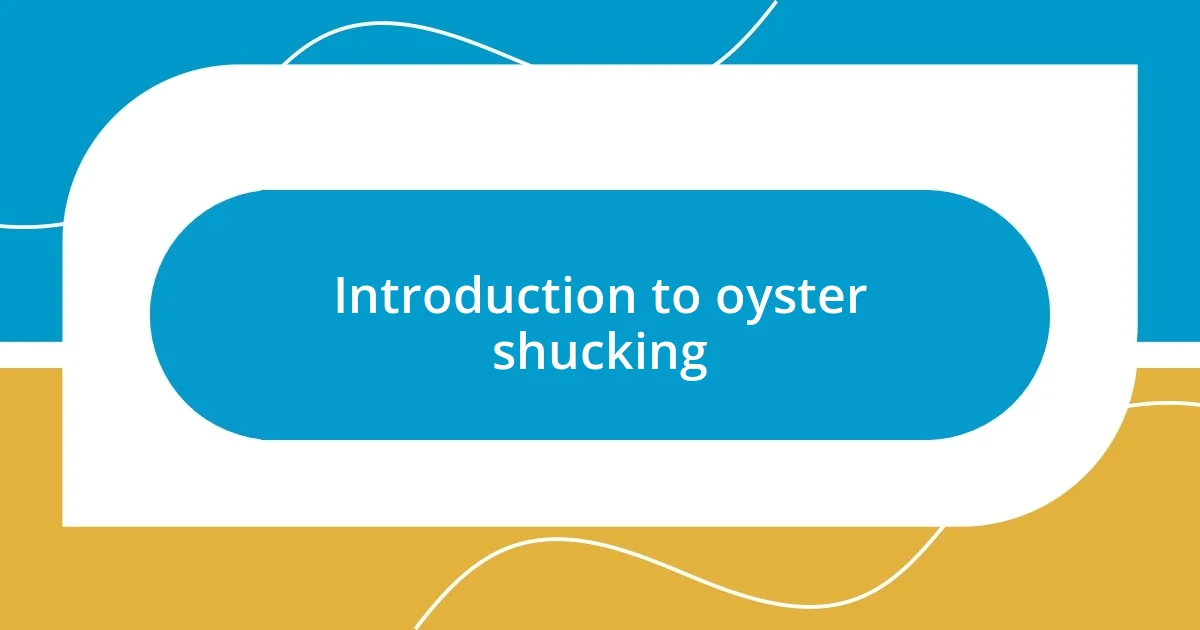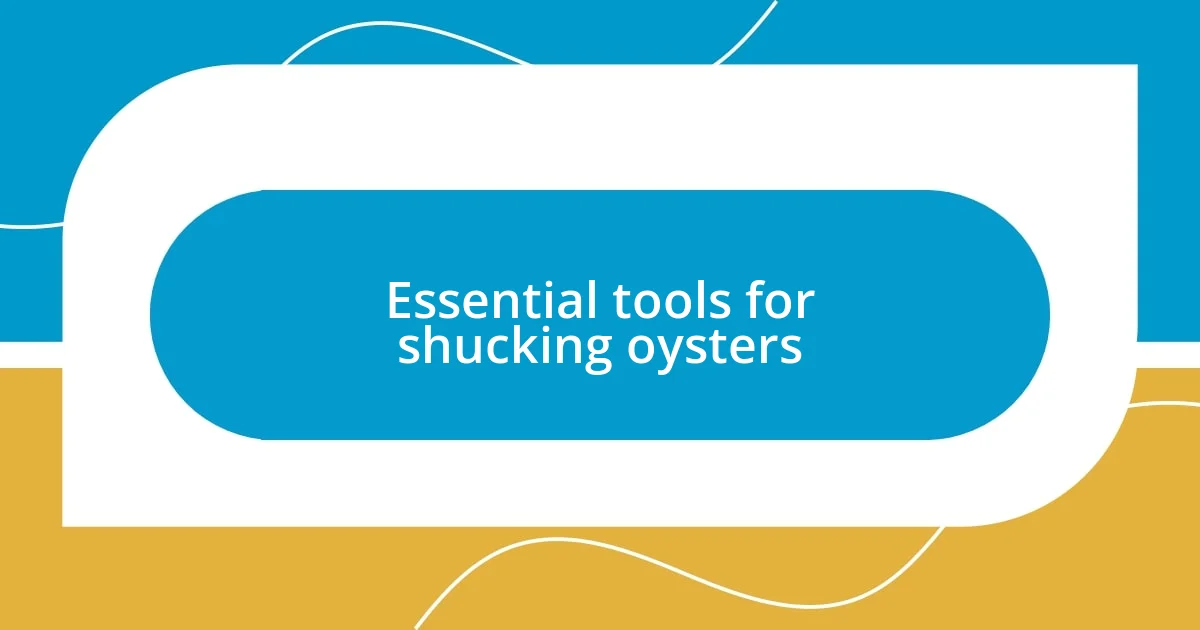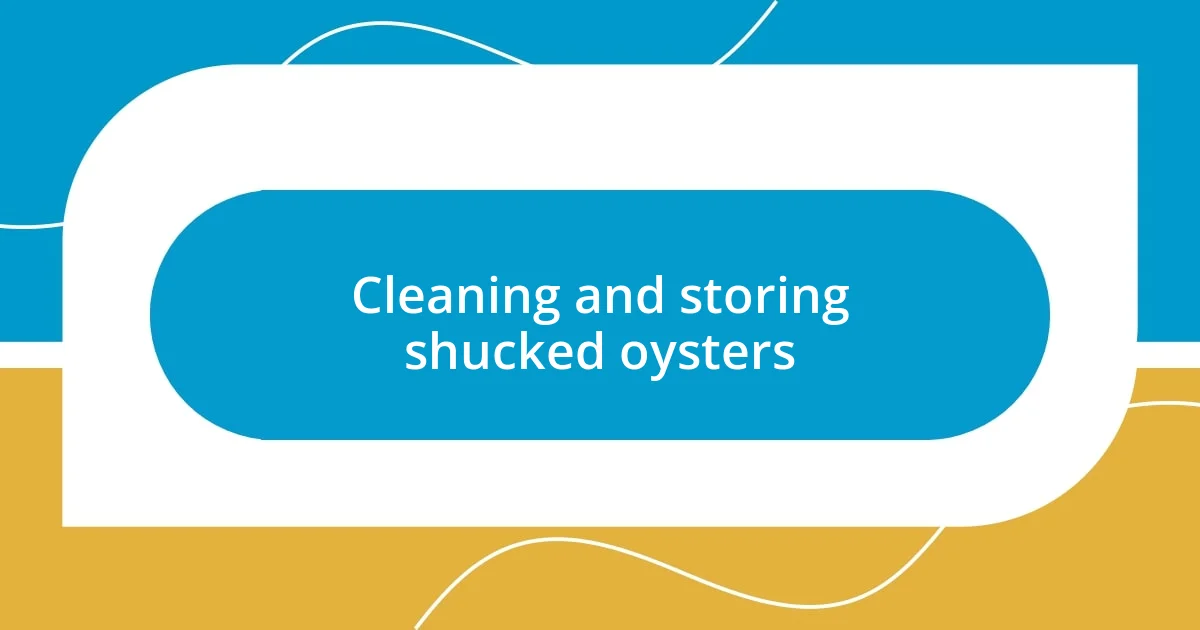Key takeaways:
- Oyster shucking requires the right tools, including a specialized oyster knife, cut-resistant gloves, and a sturdy surface for safety and precision.
- The shucking process involves specific steps: positioning the oyster, inserting the knife, applying pressure, and detaching the muscle for easy enjoyment.
- Pairing oysters with drinks enhances the experience, with sparkling wine, craft beers, and citrus cocktails providing delicious contrasts to the briny flavor of oysters.

Introduction to oyster shucking
Oyster shucking is an art that combines skill, precision, and a dash of bravery. I remember the first time I had to tackle this task; my heart raced as I held the knife, contemplating the sharp edge so close to my fingers. Isn’t it fascinating how something that seems intimidating can lead to such a rewarding experience?
When I finally managed to pop that first oyster open, it felt like unlocking a treasure chest filled with briny goodness. The satisfaction was palpable, and I couldn’t help but smile at the fresh, salty scent wafting up from the shell. Have you ever felt that rush of accomplishment when trying something new? It’s moments like these that make the effort worthwhile.
The technique of shucking oysters may appear straightforward, but there’s a technique that transforms it into a true culinary experience. Each oyster has its own personality, and getting to know how to handle each one can be both a challenge and a joy. How can you dive into this adventure without that fear holding you back? I’ve found that practice—and perhaps a few oysters sacrificed along the way—leads to fine-tuning the skill that turns shucking into an enjoyable ritual.

Essential tools for shucking oysters
When it comes to oyster shucking, having the right tools makes all the difference. I remember my first attempt—my makeshift kitchen knife was no match for the stubborn shell of the oyster. Investing in a proper oyster knife is crucial; its thin, pointed blade is designed to slide effortlessly between the shells. You’ll appreciate the precision it provides as you delicately pry them open, almost like unwrapping a present.
Another essential tool is a pair of cut-resistant gloves. I can’t emphasize this enough! The first time I shucked without them, I had a small mishap—a slip of the knife led to a minor cut. The gloves not only provide safety but also enhance your grip. The experience of shucking becomes more enjoyable when I know my hands are protected, letting me focus solely on the task at hand.
Lastly, having a sturdy surface to work on is non-negotiable. Using a cutting board can make a world of difference in stability. I often find myself shucking on a towel, which helps to keep the oyster steady while I work. A solid surface means fewer surprises and the confidence to keep going until you’ve opened them all.
| Tool | Description |
|---|---|
| Oyster Knife | A specialized knife with a thick, pointed blade designed for prying open oyster shells. |
| Cut-Resistant Gloves | Protective gloves that enhance grip and shield against sharp knife slips. |
| Cutting Board | A flat surface that provides stability while shucking oysters, essential for safety. |

Step-by-step shucking technique
Once you have your tools ready, it’s time to tackle the actual shucking process. It may feel a little daunting at first, but trust me, practice transforms this into an art form. I like to start by holding the oyster in my hand, cupped side down, with a towel underneath to catch any spills. This small step helps me maintain control. As I insert the knife into the hinge, there’s a moment of resistance that tells me I’m in the right spot.
Here’s a step-by-step breakdown of my technique:
- Position the Oyster: Hold the oyster firmly, cupping the rounded, smooth side down, letting the pointed side face up.
- Insert the Knife: Gently place the knife into the hinge where the shells meet. A little wiggling might help.
- Apply Pressure: Push down firmly until you feel the shell pop open. This is when the excitement really kicks in!
- Slide and Open: With the knife now between the shells, slide it along the top shell to detach the muscle that holds it in place.
- Remove the Upper Shell: Lift the top shell carefully, and don’t forget to let the briny liquor stay in the bottom shell—it’s a part of the experience!
- Detach the Muscle: Use the knife to cut the muscle attaching the oyster to the bottom shell, ensuring it’s ready to enjoy.
Every successful shuck fills me with such elation, almost like a little victory dance. Each oyster is its own adventure, and with every one I open, I can feel my confidence grow. By breaking down the process and taking it slow, I’ve learned that the joy lies in the journey, not just the end result.

Oyster varieties and their flavors
Understanding the various oyster varieties and their unique flavors is like embarking on a culinary adventure. I remember my first encounter with a Kumamoto oyster; it was a game-changer. Their sweet, cucumber-like taste intrigued me, and I still relive that moment when I first experienced the briny ocean essence mingling with a hint of nuttiness. Isn’t it fascinating how each variety can whisk you away to different coastal regions?
Then there are the Pacific oysters, which I’ve come to appreciate for their creamy texture and rich, savory flavor. These are often larger and have a more robust meat than other varieties. I vividly recall hosting a small gathering at my place, where I served a platter of Pacific oysters—everyone was surprised at how much character a single oyster could possess. It sparked conversations and laughter, proving that oysters are not just food; they’re a way to bring people together.
Lastly, I can’t overlook the Importance of the East Coast favorites: Blue Point and Wellfleet oysters. Their brine is sharper, often evoking memories of crisp, salty sea breezes. I had the chance to enjoy Wellfleet oysters during a trip to Cape Cod, and their clean finish left a lasting impression on my palate. Each variety tells a story, wouldn’t you agree? Each time I taste a new type, I feel like I’m not just eating—I’m exploring the world through each delightful slurp.

Pairing oysters with drinks
When it comes to pairing oysters with drinks, my go-to is sparkling wine. The effervescence cuts through the brininess beautifully, creating a delightful contrast. I still remember a gathering where I served fresh oysters alongside a crisp Champagne. The bubbles danced on my palate, and it elevated the tasting experience to a whole new level. Have you ever tried that combination? It’s a marriage that feels almost celebratory!
For something a tad different, I often explore craft beers with my oysters. The hoppy bitterness of an IPA can complement the sweet, creamy qualities of certain oyster varieties. I had a memorable evening with friends, featuring a hoppy local IPA alongside a platter of buttery Kumamoto oysters. Each sip and slurp revealed new layers of flavor that made me rethink traditional pairings. I love how exploring different flavors can lead to unexpected and delightful surprises!
Then there’s the classic duo of oysters and a citrus-forward cocktail. I’ve discovered that a zesty margarita made with fresh lime juice pairs surprisingly well with those robust Pacific oysters. One time, during a seaside cookout, I sipped on a freshly made margarita while savoring the briny oysters—I felt like I was right there on the coast! The acidity of the drink brightened the experience, confirming that sometimes, going with your gut pays off. What have you found that pairs well with your favorite oysters?

Cleaning and storing shucked oysters
Cleaning shucked oysters is essential to ensure a safe and enjoyable tasting experience. After shucking, I always rinse the oysters under cold running water to remove any grit or sand. I remember one time, I skipped this step in a rush and regretted biting into a gritty morsel—it completely changed the experience. Haven’t you felt that disappointment before when an unexpected texture interrupts a delicious moment? A good wash truly makes a difference.
Once cleaned, proper storage becomes critically important. I generally place my cleaned oysters in a sealed container lined with damp paper towels. It keeps them hydrated while preventing any odors from other foods in the fridge. I recall hosting a last-minute dinner and finding my oysters still fresh and plump days after storing them this way. Just be sure to consume them within a day or two for the best flavor, as they are best enjoyed fresh.
Temperature is also key in preserving the quality of shucked oysters. I store them in the coldest part of the fridge, which I’ve found can help extend their life. One summer, while experimenting with shucked oysters for a beach picnic, I learned the hard way that even a couple of hours at room temperature could spoil them. Ever had a beach day turn into a food safety concern? By keeping them cold, I ensure my seafood remains a delightful highlight rather than a potential regret.














